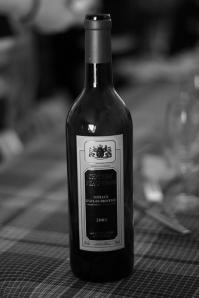 (Photo : Nicolas Sauvage)
(Photo : Nicolas Sauvage)
Aujourd’hui, quelques extrait en anglais d’un petit livre acheté à Londres intitulé “Xenophobe’s guide to the French”. Voilà comment les anglais nous perçoivent, un petit d’humour et d’auto-dérision ne font jamais de mal…
Eating
For the French, enjoyment of food in a good restaurant or in the home of a fine chef, is a spiritual experience, a neo-religious ritual. Indeed, the French find comfort, pride and solace in their food, as well as excitement and stimulation.
There are still many parts of France where two hours is allowed for lunch, though more and more people are opting for a shorter lunch-break and an earlier finish to work, so that they can get home to their families. They may then immediately go out again, en famille, to eat their evening meal, for even the humblest roadside café can offer a blanquette de veau that is every bit as good as a top-class restaurant, at a fraction of the price.
There are traditional cheeses in every region of France, and traditional pâtisseries as well - the canelles of Bordeaux, the brioches of the Vendée, the gâteaux Basques of the Pyrenées Atlantiques, the tartes aux groseilles of Bar-le-Duc, the calissons (little almond cakes) of Aix-en-Provence. There is even a little shop in St Emilion that sells macaroons made to the same recipe since 1620.
Food is no exception to the general French rule that fashion dictates everything. Nouvelle cuisine is the apotheosis of art in cooking; tiny pieces of food in a beautiful pattern - food for the eye rather than for the stomach - a triumph of style over substances. It intellectualises an essential primal function - one must eat to live, indeed, but one must live to discuss, and so food too must be worthy of analysis.
At a business conference, two French male colleagues talked together for over half a hour, not about sport or work, but about the mushrooms they had picked during the summer and how they ate them and with what sauce. Particular stress was placed on some very rare mushrooms which one of the delegates had found on a moutainside in Corsica and on the cream sauce that had accompanied them.
On the other hand, there is a lack of refinement about some French food which other find repellent. They not only eat any and every part of an animal, they take no trouble to hide what part it is. The British and the Americans mince up the toenails, genitals, brains, tails and ears of cows, pigs and sheep, turning them into unidentifiable product called ‘burgers’, ‘brawn’, ‘haslet’ or ‘luncheon meat’. The French call a pig’s foot ‘un pied de porc’ and slap it on a tray with all the rest of the much-prized charcuterie.
The gibes historically hurled at the French for eating snails, frog’s legs and garlic are ineffective. The French know how to cook, serve and eat all three. Stomachs may quail at the snail, but the melted butter will be the finest in the world. Frog’s legs may seem to provide little in the way of sustenance, but they will be exquisitely arranged on the plate.
Drinking
Only the inhabitants of Luxembourg drink more than the French, who consumes 15.5 litres of pure alcohol per head per year. In Normandy and Britanny vast quantities of cider pour down French throats and gurgle on to French livers - always a source of concern.
Beer is popular throughout France. The wealthy are fond of whisky, especially malt whiskywhich has special cachet. In south-west France, along the cosmopolitan coast, Gin Fizz is quaintly advertised in bars, a relic of older days. Pastis, Byrrh, and other apéritifs still have their customers. But it is wine that makes the French world go round. The French know about wine. (They should do; they imbibe, combined with water, an ever-increasing amount of wine at mealtimes from a tender age). Whatever the Spanish, the Germans, the Australians or the Californians may say, the French know that they produce the best wine in the world. Visitors to the Museum of Wine in Bordeaux or the University of Wine at Château Suze-la-Rousse tiptoe past the exhibits with more reverence than would be seen in Notre Dame.
A family of vegetarians, invited to dine with a French family in Bordeaux, were treated to a seven-course meal, every course of which was cheese. But, there was a different bread to go with each cheese and, most importantly, a different wine to go with each duo. The meal was wonderful, each course superbly distinguished from the others; a ‘grand vin’ here, a ‘petit vin’ there. And they awoke the following morning with no after-effects.
After a banquet, the French President of the Board of Trade addressed guests for a full ten minutes, not on the economy or international trade or tariffs and duties, but on the glories of the wines that had accompanied their meal. He dwelled at lenght on the ‘78 de la Tour and the ‘55 Sauternes. He reviewed the experience in which they had all shared, and then led the assembled gathering in an act of bibulous worship…
<< < > >>
